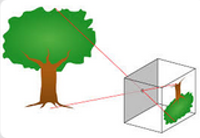
Why does the pinhole camera produce an inverted image?

A) The light passing through a convex lens produces an inverted image.
B) The light passing through a concave lens produces an inverted image.
C) The light travelling in a straight line passes through the aperture to produce an inverted image.
D) The pinhole camera produces an upright image.

Answer
557.4k+ views
Hint: The above problem is based on the working principle of the pinhole camera. The pinhole camera does not consist of any lens. It consists of a box with a small size hole, which acts as the lens for the pinhole camera. The light enters in a straight line by the aperture from top of the box to bottom. The inverted image of the object is formed inside the box.
Complete answer:
The pinhole camera does not consist of any lens, so the option (A) and option (B) are incorrect.
The light travels straight through the aperture and produces an inverted image because it is formed at the opposite side of the box. The light from the bottom of the object forms at the top of the opposite side and light from the top of the object goes to the bottom of the box. The pinhole camera does not produce an upright image, so the option (D) is incorrect.
Thus, option (C) is correct.
Additional Information:
The inverted image formed in the box is a virtual image, so the size of the inverted image becomes greater than the actual size of the object. The size of the image also varies according to the size of the aperture of the hole of the pinhole camera.
Note: Always remember that the light entering the pinhole camera through a small aperture is straight. The size of the hole must be very small. The must be light-proof and no dust present inside the box.
Complete answer:
The pinhole camera does not consist of any lens, so the option (A) and option (B) are incorrect.
The light travels straight through the aperture and produces an inverted image because it is formed at the opposite side of the box. The light from the bottom of the object forms at the top of the opposite side and light from the top of the object goes to the bottom of the box. The pinhole camera does not produce an upright image, so the option (D) is incorrect.
Thus, option (C) is correct.
Additional Information:
The inverted image formed in the box is a virtual image, so the size of the inverted image becomes greater than the actual size of the object. The size of the image also varies according to the size of the aperture of the hole of the pinhole camera.
Note: Always remember that the light entering the pinhole camera through a small aperture is straight. The size of the hole must be very small. The must be light-proof and no dust present inside the box.
Recently Updated Pages
Master Class 6 English: Engaging Questions & Answers for Success

Master Class 6 Social Science: Engaging Questions & Answers for Success

Master Class 6 Maths: Engaging Questions & Answers for Success

Master Class 6 Science: Engaging Questions & Answers for Success

Class 6 Question and Answer - Your Ultimate Solutions Guide

Master Class 11 Economics: Engaging Questions & Answers for Success

Trending doubts
How many seconds are there in an hour class 6 maths CBSE

Give 10 examples for herbs , shrubs , climbers , creepers

What is the capital city of Australia? A) Sydney B) Melbourne C) Brisbane D) Canberra

Four bells toll together at 900am They toll after 7811 class 6 maths CBSE

A clock is set to show the correct time at 11 am the class 6 maths CBSE

What is meant by exothermic and endothermic reactions class 11 chemistry CBSE





